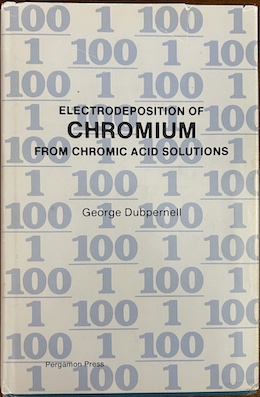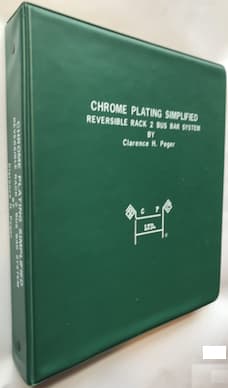
Curated with aloha by
Ted Mooney, P.E. RET

The authoritative public forum
for Metal Finishing 1989-2025

-----
Pros and Cons of Trivalent chrome plating
Q. We have hex and are thinking about switching to tri chrome.
Does tri cover better on pits? Belt line or buffing marks?
What's the difference? Advantages or disadvantages
- BG, Kentucky
October 26, 2022
⇩ Related postings, oldest first ⇩
Q. I am aware about the toxic nature of hexavalent chrome plating and its ill effects. Is there an replacement? How about trivalent chrome plating. Can anyone help me about the nature of bath composition? Where are these types of plating carried out?
Pintu Bstudent - Mumbai, Maharashtra, India
2004
for Shops, Specifiers, & Engineers

by Weiner & Walmsley (1980)
avail from eBay, AbeBooks, or Amazon

by Robert K. Guffie (1986)
avail from AbeBooks, or Amazon

avail from eBay, AbeBooks, or Amazon
"Hard chromium plating: A Handbook of Modern Practice"
by John David Greenwood (1971)
avail from eBay

very rarely avail from Amazon
but copies are available in a few libraries)
"A Chromium Plating Bath With The Fluoride Ion"
by Alfred Perlenfein (2013)
avail from eBay, AbeBooks
(as an Amazon Associate & eBay Partner, we earn from qualifying purchases)
A. Hi Pintu.
Actually the chromium plating is metal of oxidation state zero and is not toxic, regardless of which solution it was plated from. The process of applying the chrome plating may, however, involve hexavalent chromic acid, and that is a toxic material that needs to be properly managed to avoid air, water, or land pollution and to prevent exposure of personnel to it. It was widely mismanaged for decades, so it is understandable that people would be afraid of it.
Plating from a trivalent chromium bath is one alternative process and there are several different proprietary approaches. Each of the major international plating suppliers offers their own proprietary trivalent chromium plating process. I do not think there is any published generic approach for trivalent chromium plating. Trivalent chromium plating is done on a wide variety of parts that require very thin chromium or decorative chromium plate; I have seen it done on circular saw blades, and hand tools, and know it to be done on many other parts.

Ted Mooney, P.E.
Striving to live Aloha
finishing.com - Pine Beach, New Jersey
Multiple threads merged: please forgive chronology errors and repetition 🙂
Q. What are the disadvantages of using trivalent chromium for hard chrome plating processes?
Tameshwar Ramphalengineering - Trinindad
2006
A. The major disadvantage may be that it can't be done at present, Tameshwar :-)
At the most recent Sur/Fin conference, one of the major suppliers seemed to be hinting that very thin hard chrome may be possible from the latest generation of trivalent plating solutions, but to my knowledge it is not yet a proven commercial practice.

Ted Mooney, P.E.
Striving to live Aloha
finishing.com - Pine Beach, New Jersey
A. Toxicity of Cr+6, low current efficiency, poor metal distribution, burns in high-current-density areas, "white-wash" and lack of coverage around holes are some of the problems associated with Cr+6 plating baths. These factors led to the eventual development of a safer and more efficient system, based on trivalent chromium.
Trivalent chromium plating baths for decorative applications enjoyed a steady, although initially slow, acceptance as a substitute for hexavalent chromium plating. Their main attraction lies in the fact that they eliminate many of the shortcomings of hexavalent chromium solutions.
Color was a big problem of trivalent chromium plating. The plate was darker and not as shiny. This problem has been greatly reduced. The trivalent chrome systems developed by some suppliers produce plates that are as shiny and of as high a quality as hexavalent chrome plates. If the trivalent chrome parts are placed side by side with hexavalent chrome parts, however, there is a noticeable color difference.
The cost of chemicals for a trivalent system is currently higher than for a hexavalent set-up, although this might change as trivalent systems become more common.

David Shiu
- Singapore
Q, A, or Comment on THIS thread -or- Start a NEW Thread
